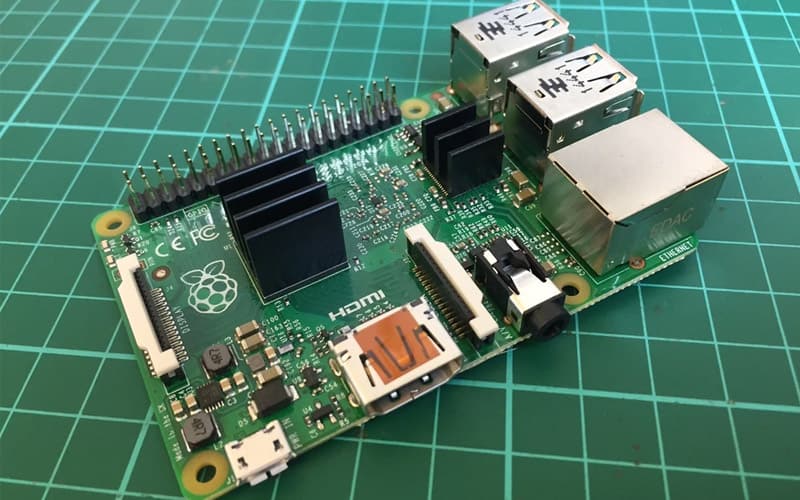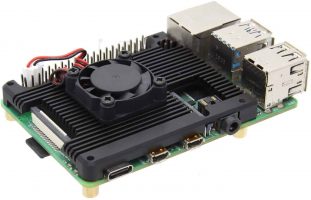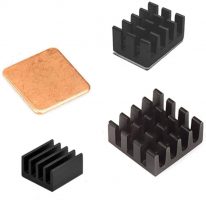Best Raspberry Pi Heatsink in 2021
Ward off thermal throttling with the best Raspberry Pi heatsinks
- Last Updated May 28, 2021

A heat sink is hands-down one of the least expensive and easiest upgrades you can make to the Raspberry Pi. It’s a cost-effective way to ward off thermal throttling and prolong the longevity of a Raspberry Pi. There’s little out there in the way of near-effortless upgrades that produce such a tangible improvement to performance.
The Pi runs hot, dangerously so when used for resource-hungry applications, to the point that the system features an integrated temperature sensor that will downclock the CPU to avoid overheating damage when the Pi creeps above 82-degrees. For short, heavy loads, this may not be an issue, but the problem really comes into focus for projects subjecting the Raspberry Pi to prolonged loads. In these cases, the thermal throttling can kick in and effectively handicap the Pi’s processing potential, which can have serious implications for performance.
If you’re battling high temperatures or simply want to prepare for all eventualities, you’ve come to the right place. Today, we’re diving headfirst in the world of Raspberry Pi heat sinks, paddling cautiously past the useless duds to find the very best currently on the market. Let’s dive in.
Products at a Glance
How We Picked
Materials, size, thickness, design, adhesive properties, cooling performance, and cost – these are all factors we took into account when searching for the best Raspberry Pi heatsinks on the market. We favored heatsinks that carefully balanced all these with a particular emphasis on real-world heat dissipation performance.
A quick search of big retailer websites, such as Amazon, reveals a wealth of options, complicating settling on a good quality Raspberry Pi heatsink. After sifting through much of what’s out there, we narrowed our recommendations to four top picks. These cover a range of form factors from case-style heatsinks to small individual heatsinks and budget options by way of embedded heatsinks that cover most of the Raspberry Pi’s surface.
Read on to find a brief introduction to each alongside a quick look at what they do well and where they falter. At the end, we’ve included a ‘Things to Consider’ section featuring a few top pointers to aid your Raspberry Pi heatsink shopping experience.
Best Raspberry Pi Heatsink in 2021
Embedded aluminum heatsink design
Active and passive cooling
Low profile fan
Sits flush with the Pi
Full access to GPIO
Only compatible with Raspberry Pi 4
Our top pick is the Geekworm Raspberry Pi Embedded Heatsink with Fan chiefly because it offers an all-in-one active and passive cooling solution, canceling out the need to source a fan to accompany the heatsinks found in most other options on the market. Priced at just under $11, it’s also highly affordable.
Doing most of the heavy lifting is a low-profile 7mm thick armor aluminum heatsink that sits above most of the Raspberry Pi board, covering the components that tend to give off the most heat when the Pi is subject to heavy loads. Once fixed to the Pi via the four existing mounting holes on the Pi, the Geekworm Raspberry Pi Embedded Heatsink with Fan doesn’t surpass the USB and LAN ports on the back of the Pi in height. The heatsink is designed to allow easy access to both the GPIO and connectors on the board like the Camera Serial Interface without obstructing any of the HDMI, LAN, audio, or USB ports, making it a top pick for those that plan to employ HATs and expansion boards.
Two protruding blocks align perfectly with the CPU and RAM on the Pi to dissipate heat efficiently. Contact with these is assured thanks to the provided good quality thermal tape. Geekworm has even thrown in six spacer packs of different heights to ensure a snug fit and ensure compatibility with all manner of HATs.
Alongside, the Geekworm Raspberry Pi Embedded Heatsink with Fan also includes a 25 mm removable fan to throw some active cooling into the mix. Operational noise levels are low, even under heavy loads, and when combined with the large heatsink, do an excellent job of keeping temperatures down with results numbered in the double digits compared to using the Pi without a heatsink and fan combo.
Due to its design, the Geekworm Raspberry Pi Embedded Heatsink with Fan is only compatible with the Raspberry Pi 4, something to keep in mind if you are working with a previous-generation Pi.
Case form factor heatsink
Quality construction
Dual fans
Quiet
Access to GPIO, connectors, and ports
SD Card slot is covered once assembled
Only compatible with Raspberry Pi 4
The MazerPi Armor Heatsink & Dual Fan piqued our interest and secured a spot among our top recommendations for not just offering top-notch cooling performance but also a case form factor. Much like the heatsink above, it’s an all-in-one solution that provides everything required to keep those Pi temperatures in check.
The MazerPi Armor Heatsink & Dual Fan consists of two layers. The top covers the entire surface of the Raspberry Pi with a CNC aluminum alloy heatsink. Its width matches that of the back USB and LAN ports on the Pi, so we are looking at a small form factor case that’s much more contained than some of the larger cases on the market. The heatsink features a cut-out for a pair of fans that add some active cooling to the setup. These sit flush with the top of the heatsink for a tidy overall look and feel.
The second layer sits under the Raspberry Pi and is yet another aluminum heatsink with an indented heat dissipation pattern to aid cooling. The two layers attach via the existing mounting holes on the Pi, which makes for easy installation and doesn’t obstruct the GPIO, onboard connectors, or ports other than the SD Card, which is inaccessible once the MazerPi Armor Heatsink & Dual Fan is assembled. The case ships with decent-quality thermal tape, too.
When combined, these two layers and the dual fans offer some serious cooling performance, which can reduce temperatures by 20 to 30-degrees under heavy loads, well clear of the 82-degrees thermal throttling threshold. The operational noise levels of the fans are very low, so no pesky whirring or humming to contend with here. Additionally, the overall construction quality of the parts is excellent, and you can sense from handling the MazerPi Armor Heatsink & Dual Fan that it’s built to last.
One of the few issues we have with the MazerPi Armor Heatsink & Dual Fan is limited compatibility with Raspberry Pi versions: it’s only really designed to sit atop a Raspberry Pi 4.
100 piece kit
Variety of sizes
Both aluminum and copper heatsinks
Pre-applied high-performance thermal tape
Reasonably-priced
Overkill for single Pi projects
Moving away from larger form factor heatsink options, we have the Pastall Heatsink Kit. As the name suggests, this is a kit, or rather a large selection of different heatsinks suitable for the Raspberry Pi.
The Pastall Heatsink Kit features no less than 100 pieces, broken down into eight different sizes: 10 pack of 14 mm x 14 mm x 7 mm aluminum heatsinks, 10 pack of 14 mm x 9 mm x 5 mm aluminum heatsinks with a staggered W-shaped top, 20 pack of 9 mm x 9 mm x 5 mm aluminum heatsinks with a staggered W-shaped top, 10 pack of 14 mm x 14 mm x 5 mm aluminum heatsinks, 10 pack of 14 mm x 9 mm x 5 mm aluminum heatsinks with a straight W-shaped top, 20 pack of 9 mm x 9 mm x 5 mm heatsinks W-shaped top, 10 pack of 12 mm x 12 mm x 1 mm copper heatsinks, and finally a 10 pack of 14 mm x 14 mm x 1 mm copper heatsinks.
Each of the 100 pieces comes with pre-applied high-performance, high-viscosity, durable thermal conductive adhesive and are sized to fit on the CPU, RAM, LAN module, and USB module on the Raspberry Pi. The different sizes also mean broad compatibility with most if not all Raspberry Pi versions.
While cooling performance is very much dependent on the project and whether the heatsinks are paired with a cooling fan, we found all the parts in the Pastall Heatsink Kit to be of a high standard with excellent heat dissipation properties even under heavy loads.
The 100 pieces may be overkill for those that want to equip a single Raspberry Pi with a cooling solution (see our budget pick below if that rings true for you), but for those that dabble with numerous devices and want backup heatsinks, this is a cost-effective solution.
Four piece heatsink kit
Good Raspberry Pi version compatibility
Pre-applied thermal adhesive
Low cost
Requires a fan to handle the heaviest loads
Finally, we come to our top budget pick. We understand that due to the low cost of the Pi, some may be reluctant to pay upwards of a third of the cost of the board itself for a cooling solution. In that case, there are plenty of decent low-cost options out there, and among them, the Easycargo Raspberry Pi 4 Heatsink Kit is among the best, priced at an ultra-low $4.
The Easycargo Raspberry Pi 4 Heatsink Kit includes four heatsinks – three black anodized aluminum, and one copper – cut to size to fit on top of the CPU, RAM, LAN module, and USB module on the Raspberry Pi 4. However, they can also be used with the Raspberry Pi Model B+ and Raspberry Pi 3 Model B. They are also low-profile enough to accommodate most standard Raspberry Pi cases.
Each of the heatsinks found in the Raspberry Pi 4 Heatsink Kit comes with pre-applied thermal adhesive, which, in our experience, has good heat conductivity properties and sits firmly atop the parts. In action, the Easycargo Raspberry Pi 4 Heatsink Kit drops temperatures below 50-degrees with ease and lower when the Pi is idle. You won’t get the same results as the more complete options above, but the cooling performance is impressive at this price point.
For general-use applications and more modest projects, the Easycargo Raspberry Pi 4 Heatsink Kit will do just fine. Still, if you plan to dabble in overclocking or subject the Pi to prolonged loads, we suggest pairing the heatsinks with a fan to combine both active and passive cooling. Unfortunately, as this is a heatsink kit, you’ll need to source a fan or case that includes one elsewhere, but these are easily found and affordably priced.
Things To Consider
Our Verdict
If you’re plagued by indecision at the sheer breadth of choice out there, the Geekworm Raspberry Pi Embedded Heatsink with Fan is a complete active and passive cooling solution aptly tooled to handle even the heaviest loads. The low profile should please those that want a small form factor solution. Limited Raspberry Pi 4 compatibility excludes other Pi versions, though.
For those that want a heatsink that conveniently doubles as a compact, stylish case, the MazerPi Armor Heatsink & Dual Fan ticks all the boxes. Expect excellent cooling performance, quality construction, and quiet operation thanks to two CNC aluminum heatsinks and a pair of high-quality fans. Good access to the GPIO and connectors scores points, especially for projects that incorporate HATs and favor expansion.
With 100 pieces, the Pastall Heatsink Kit features all the types and sizes of heatsink you’ll ever need to equip dozens of Raspberry Pi boards with the right tools to keep temperatures well away from the thermal throttling cap. One for tinkerers juggling multiple Pi projects that need backup heatsinks.
Finally, the Easycargo Raspberry Pi 4 Heatsink Kit reminds us that there’s no need to spend too much on Raspberry Pi heatsinks. The four-piece kit has everything you need to easily install a robust cooling solution, simply remember to incorporate a fan if you’re dabbling with heavy, persistent loads.
Any pressing questions or concerns? Drop us a line in the comments section below.




